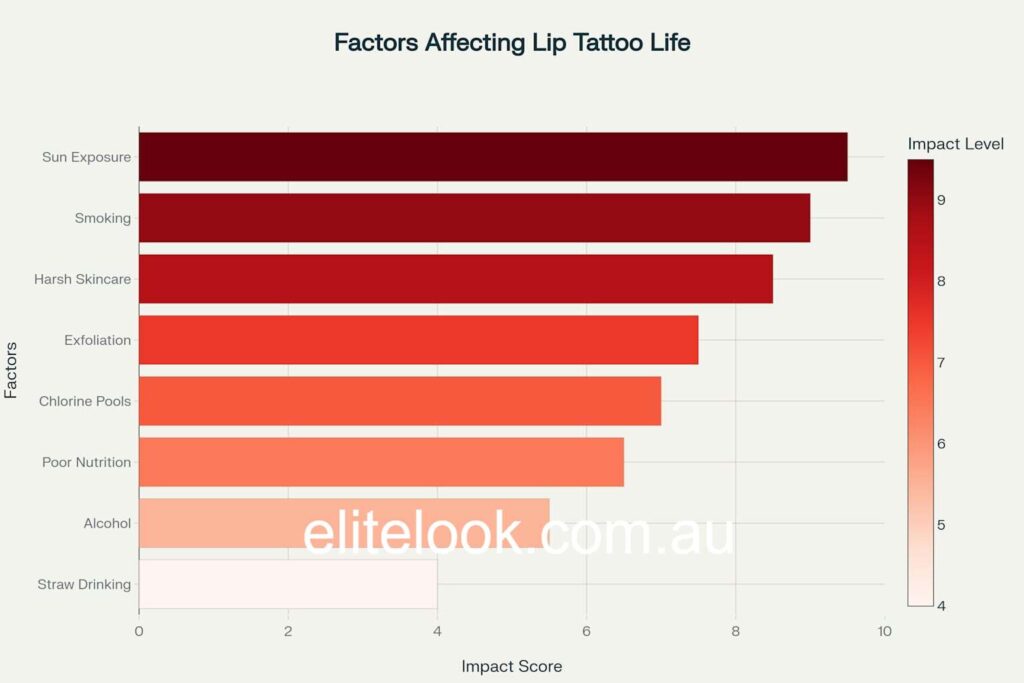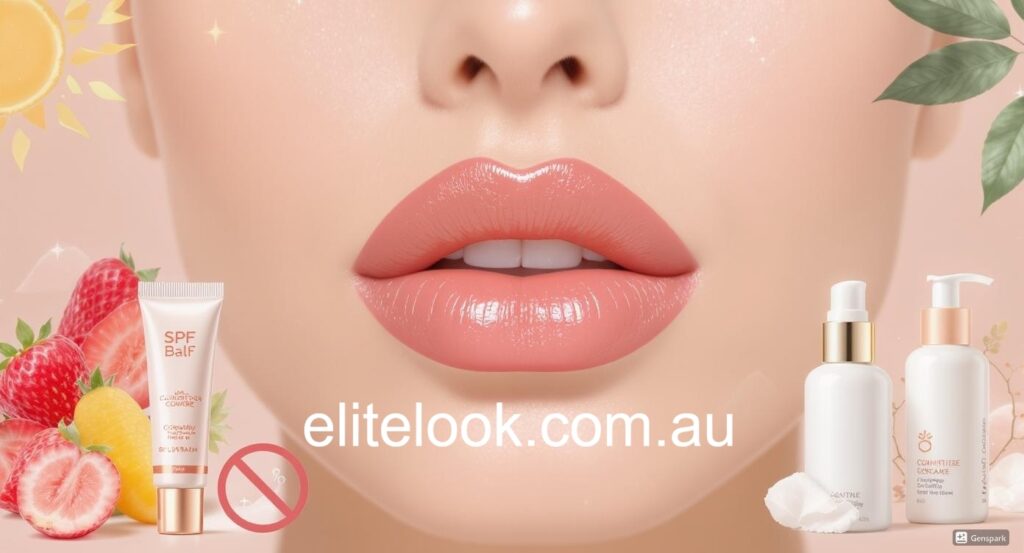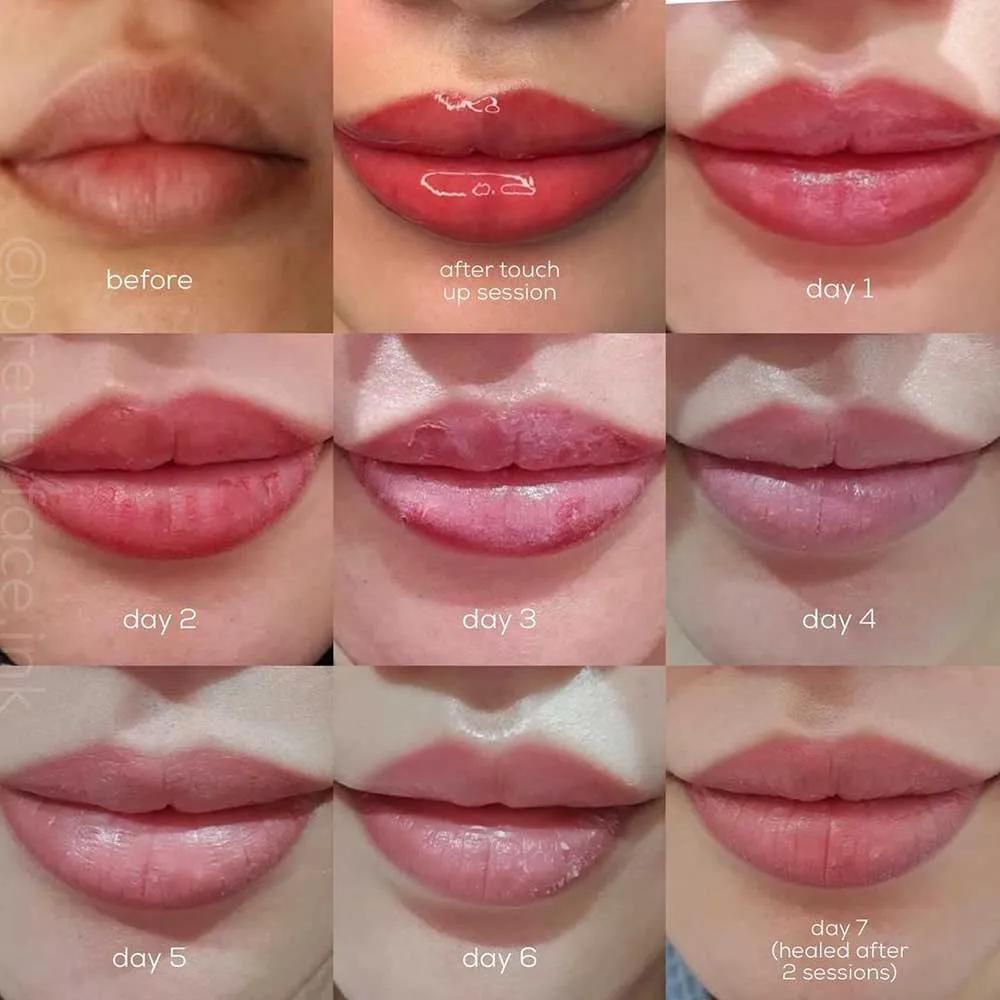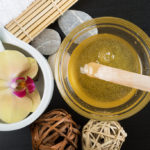
How Your Lifestyle Impacts Your Lip Tattoo Results
Your $500+ Investment Deserves Better Care Than You Think 💄
Have you ever wondered why some people’s lip tattoos look fresh after two years while others fade within months? The secret isn’t just in the artist’s skill or the pigment quality—it’s in the daily choices you make after leaving the studio.
Your lifestyle acts like a silent partner in your lip tattoo journey. Every sip of coffee, every day at the beach, and every skincare routine either protects your investment or slowly chips away at it. The four biggest lifestyle factors—sun exposure, smoking, skincare choices, and diet—can make the difference between stunning, long-lasting results and disappointing fading.
Think about it: you’ve invested hundreds of dollars and endured the discomfort for beautiful, lasting lips. Shouldn’t you know exactly how to protect that investment?
This guide breaks down the science behind lifestyle impacts in simple terms. You’ll discover which daily habits are secretly sabotaging your results and learn practical strategies to keep your lip tattoo looking vibrant for years. No medical jargon, no complicated routines—just straightforward advice that actually works.
Ready to become your lip tattoo’s best friend? Let’s dive into the four lifestyle factors that can make or break your beautiful new lips! ✨
1. Sun Exposure: Your Lip Tattoo’s Biggest Enemy ☀️
Why Does the Sun Hate Your Lip Tattoo?
Picture your lip tattoo pigments as tiny colored particles sitting in your skin. When UV rays hit them, they start breaking apart like a cookie crumbling in your hands. This isn’t just surface damage—it’s happening deep in your lip tissue where the pigment lives.
Your lips are especially vulnerable because the skin there is much thinner than the rest of your face. It’s like comparing tissue paper to cardboard. That delicate lip skin offers almost no natural protection against UV damage, making your tattoo pigments sitting ducks for sun damage.
What Really Happens When Sun Hits Your Lips?
The science is actually pretty simple. UV radiation breaks down the chemical bonds in tattoo pigments, causing them to fragment into smaller, less visible pieces. Some pigments even change color entirely—reds might turn orange, and deep berry shades can fade to an unflattering brown.
But here’s what most people don’t realize: sun damage is cumulative. Every unprotected moment adds up. That quick walk to your car, those few minutes waiting for the bus, that afternoon by the pool—they’re all contributing to gradual fading.
The Two Types of Sun Damage You Need to Know About
Immediate Effects (First 6 Months):
- Color appears lighter or washed out
- Uneven fading in spots that get more sun exposure
- Pigment looks patchy or blotchy
Long-term Effects (1-3 Years):
- Significant color loss requiring earlier touch-ups
- Complete pigment breakdown in heavily exposed areas
- Color shifting to unnatural tones
Your Daily Sun Protection Game Plan
Morning Routine: Apply SPF 30+ lip balm as part of your daily routine. Look for zinc oxide or titanium dioxide—these physical sunscreens work better on lips than chemical ones. Reapply every 2 hours, just like regular sunscreen.
Smart Timing: Avoid direct sun exposure between 10 AM and 4 PM when UV rays are strongest. If you must be outside, seek shade whenever possible and wear a wide-brimmed hat that actually covers your face.
Product Recommendations:
- Physical sunscreen lip balms with SPF 30-50
- Lip products with zinc oxide as the primary ingredient
- Tinted lip balms that provide both protection and color enhancement
Special Situations That Need Extra Protection
Beach and Pool Days: Apply SPF lip balm before and after swimming. Water reflects UV rays, doubling your exposure. Consider wearing a wide-brimmed hat even in the water.
Winter Sports: Snow reflects up to 80% of UV rays. Your lips can burn even on cloudy ski days. Use a higher SPF (50+) for winter sports.
Car Travel: Windows don’t block all UV rays. If you’re a frequent driver, pay extra attention to lip protection during long commutes.
2. Smoking: The Silent Saboteur of Your Lip Investment 🚫🚬
The Harsh Truth About Smoking and Your Lip Tattoo
Let’s be completely honest: smoking is probably the worst thing you can do to your new lip tattoo. It’s not just about the healing period—smoking continues to damage your pigment long after your lips have healed.
When you smoke, you’re exposing your lips to extreme heat (over 1,000°F at the cigarette tip) and over 70 cancer-causing chemicals. These chemicals don’t just pass by your lips—they absorb into the tissue and interfere with the pigment at a molecular level.
How Smoking Destroys Your Tattoo Investment
During Healing (First 2 Weeks): The chemicals in cigarettes reduce blood flow to your lips, slowing the healing process dramatically. This means your body can’t properly integrate the pigment, leading to patchy, uneven results.
Heat Damage: Every puff exposes your lips to temperatures that literally cook the delicate pigment particles. Think of it like leaving a photograph in a hot car—the colors fade and distort.
Chemical Breakdown: Nicotine and tar create free radicals that attack pigment molecules. These same chemicals that yellow your teeth and fingers are doing similar damage to your lip tattoo.
The Real Timeline: Smoking vs. Healing
Immediate Post-Procedure (24-48 Hours): Even one cigarette can introduce bacteria into the healing wounds and slow recovery by up to 50%. The sucking motion also puts pressure on delicate healing tissue.
First Week: Smoking during this crucial period often results in color loss that never fully recovers. Many artists won’t guarantee their work if clients smoke during healing.
Long-term (Months to Years): Smokers typically need touch-ups 40-60% more frequently than non-smokers. The constant chemical exposure keeps breaking down pigment even after complete healing.
Vaping: Is It Really Better?
Unfortunately, vaping isn’t much better for your lip tattoo. While it eliminates some harmful chemicals, it still exposes your lips to heat and nicotine. The sucking motion can also disrupt healing tissue and introduce bacteria.
E-cigarette Specific Concerns:
- Propylene glycol (common in vape juice) can be drying and irritating to healing lips
- Flavoring chemicals may react with tattoo pigments
- The heat, while lower than cigarettes, still damages delicate pigment particles
Your Smoking Cessation Strategy for Better Results
Pre-Procedure Planning: Stop smoking at least 2 weeks before your appointment. This gives your blood circulation time to improve and your immune system to strengthen.
During Healing (Critical 2-Week Period): Complete cessation is non-negotiable. Consider this your motivation to quit entirely—your lip tattoo investment depends on it.
Alternative Stress Management:
- Practice deep breathing exercises
- Use stress balls or fidget toys
- Try nicotine replacement therapy (patches, not gum that touches lips)
- Consider meditation apps for immediate stress relief
Real Success Story: Many clients report that protecting their lip tattoo investment becomes the motivation they needed to quit smoking permanently. One client shared: “I spent $600 on my lips. Every time I wanted a cigarette, I reminded myself I’d be literally burning my money.”
3. Skincare Routines: Friend or Foe to Your Lip Tattoo 🧴✨
The Skincare Ingredients That Are Secretly Ruining Your Results
Your skincare routine might be working against your lip tattoo without you even knowing it. Many common ingredients that are great for your face can be devastating to tattooed lips.
The biggest culprits are exfoliating ingredients. These work by breaking down and removing skin cells—exactly what you don’t want happening to skin that contains your precious pigment.
The Hall of Fame for Pigment Destruction
Retinol and Retinoids: These anti-aging superstars speed up cell turnover, which sounds great until you realize they’re also speeding up the loss of pigment-containing skin cells. Even if you’re not applying retinol directly to your lips, it can migrate during sleep.
Alpha Hydroxy Acids (AHAs): Glycolic acid, lactic acid, and citric acid all dissolve the bonds between skin cells. This makes your complexion glow but makes your lip tattoo fade faster than a summer tan.
Beta Hydroxy Acid (BHA): Salicylic acid penetrates deep into pores, potentially reaching the layer where your pigment lives. It’s particularly problematic because it’s oil-soluble and can penetrate deeper than water-based acids.
Physical Exfoliants: Scrubs, brushes, and exfoliating gloves can physically wear away pigment-containing skin. Even gentle facial cleansing brushes can be too harsh for tattooed lips.
Building a Lip-Tattoo-Friendly Skincare Routine
The Safe Zone – Ingredients That Won’t Harm Your Investment:
- Hyaluronic acid (provides hydration without exfoliation)
- Ceramides (strengthen skin barrier)
- Niacinamide (reduces inflammation without exfoliating)
- Gentle, fragrance-free moisturizers
- Mineral sunscreens
Pre-Procedure Preparation (2 Weeks Before): Stop using all exfoliating products around your mouth area. Switch to gentle, fragrance-free cleansers and moisturizers. This prepares your skin for optimal pigment retention.
Post-Healing Maintenance Routine:
Daily Cleansing: Use a gentle, fragrance-free cleanser. Avoid cleansing brushes or washcloths around your lip area. Pat dry instead of rubbing.
Moisturizing: Apply a lip-safe moisturizer twice daily. Look for products specifically designed for sensitive or post-procedure skin.
Weekly Maintenance: You can resume gentle exfoliation on the rest of your face, but create a “lip-free zone” about half an inch around your mouth.
Product Application Strategies That Protect Your Investment
The Buffer Zone Method: When applying face products, create a protective barrier around your lips using petroleum jelly or a thick lip balm first. This prevents active ingredients from accidentally touching your tattooed area.
Separate Product Strategy: Use different products for your lip area versus the rest of your face. Keep a separate, gentle routine specifically for the mouth area.
Application Tools: Use cotton swabs or small brushes for precise application of face products, avoiding the lip area entirely.
Common Skincare Mistakes That Cost You Color
Mistake #1: Using Face Masks That Overlap Lips Many face masks contain AHAs or other exfoliating ingredients. Always check the ingredient list and avoid the lip area entirely.
Mistake #2: Assuming “Natural” Means Safe Lemon juice, apple cider vinegar, and other natural acids can be just as damaging as synthetic exfoliants.
Mistake #3: Not Reading Ingredient Lists Many products contain multiple types of acids. Always check the full ingredient list, not just the marketing claims.
4. Diet: The Overlooked Factor in Lip Tattoo Success 🥗💊
Why What You Eat Affects How You Heal
Most people focus on external care and completely ignore how their diet impacts their lip tattoo results. But here’s the thing: your body builds new skin cells from the nutrients you provide it. Poor nutrition equals poor healing and faster pigment loss.
Your body treats your lip tattoo like any other wound that needs healing. Without the right building blocks—proteins, vitamins, and minerals—your body can’t create healthy skin cells that properly hold pigment.
The Healing Heroes: Foods That Boost Your Results
Protein Powerhouses: Your body needs protein to build new skin cells and repair tissue. Aim for lean proteins like chicken, fish, eggs, and legumes. If you’re vegetarian, combine beans and rice for complete amino acid profiles.
Vitamin C Champions: This vitamin is crucial for collagen production, which helps your skin hold pigment better. Load up on oranges, strawberries, bell peppers, and broccoli. Your daily goal should be at least 75-90mg.
Zinc Heroes: Zinc accelerates wound healing and helps maintain healthy skin. Find it in oysters, pumpkin seeds, beef, and chickpeas. Most people need about 8-11mg daily.
Omega-3 All-Stars: These healthy fats reduce inflammation and keep skin supple. Salmon, walnuts, and flaxseeds are excellent sources. Aim for 2-3 servings of fatty fish per week.
The Hydration Game-Changer
Water isn’t just good for you—it’s essential for pigment retention. Well-hydrated skin holds pigment better and heals more efficiently. Dehydrated skin becomes tight and flaky, potentially taking pigment with it as it sheds.
Daily Hydration Goals:
- Drink at least 8 glasses of water daily
- Eat water-rich foods like cucumbers, watermelon, and soups
- Limit dehydrating beverages like alcohol and excessive caffeine
- Monitor your urine color—pale yellow indicates good hydration
Foods to Avoid During Healing (First 2 Weeks)
Inflammatory Foods:
- Processed foods high in sugar and refined carbs
- Excessive dairy (can increase inflammation in some people)
- Trans fats found in fried and packaged foods
- Excessive alcohol (impairs healing and dehydrates)
Spicy and Acidic Foods: During the initial healing period, avoid foods that can irritate your lips:
- Hot peppers and spicy sauces
- Citrus fruits (oranges, lemons, limes)
- Tomato-based products
- Vinegar-heavy foods
Your Healing Meal Plan Strategy
Week 1-2 (Critical Healing Period):
Breakfast Options:
- Scrambled eggs with spinach (protein + iron)
- Greek yogurt with berries (protein + vitamin C)
- Oatmeal with nuts and seeds (fiber + healthy fats)
Lunch Ideas:
- Grilled chicken salad with colorful vegetables
- Lentil soup with whole grain bread
- Quinoa bowl with roasted vegetables
Dinner Suggestions:
- Baked salmon with sweet potato and steamed broccoli
- Lean beef stir-fry with bell peppers
- Tofu and vegetable curry with brown rice
Snack Options:
- Apple slices with almond butter
- Handful of mixed nuts
- Hummus with carrot sticks
Supplements That Support Healing
The Essential Trio:
- Vitamin C (500-1000mg daily): Boosts collagen production
- Zinc (15-30mg daily): Accelerates wound healing
- Omega-3 (1000mg daily): Reduces inflammation
Timing Matters: Take supplements with food to improve absorption and reduce stomach irritation. Start supplementation a week before your procedure and continue for 4-6 weeks after.
Important Note: Always consult with your healthcare provider before starting new supplements, especially if you take medications or have health conditions.
Table 1. Food that helps lip tattoo healing.
| Food Category | Recommended Foods | Benefits |
|---|---|---|
| Proteins | Lean chicken & turkey | Tissue repair & collagen production |
| Proteins | Fish (salmon, sardines) | Omega-3 for healing |
| Proteins | Eggs | Complete amino acids |
| Proteins | Greek yogurt | Probiotics & protein |
| Vitamin C Sources | Blueberries & strawberries | Antioxidants & collagen support |
| Vitamin C Sources | Bell peppers | High vitamin C content |
| Vitamin C Sources | Kiwi fruit | Anti-inflammatory properties |
| Vitamin C Sources | Leafy greens | Iron & folate |
| Hydrating Foods | Cucumber | Natural hydration |
| Hydrating Foods | Watermelon | Hydration & vitamins |
| Hydrating Foods | Coconut water | Electrolyte balance |
| Hydrating Foods | Herbal teas | Gentle hydration |
| Anti-inflammatory | Turmeric | Reduces inflammation |
| Anti-inflammatory | Ginger | Anti-inflammatory |
| Anti-inflammatory | Avocado | Healthy fats |
| Anti-inflammatory | Walnuts | Omega-3 fatty acids |
| Soft Foods (First Week) | Smoothies | Easy to consume |
| Soft Foods (First Week) | Oatmeal | Gentle texture |
| Soft Foods (First Week) | Soup (lukewarm) | Warm & soothing |
| Soft Foods (First Week) | Mashed banana | Soft & nutritious |
Long-term Dietary Strategies for Pigment Longevity
The Anti-Inflammatory Lifestyle: Focus on a Mediterranean-style diet rich in fruits, vegetables, whole grains, and healthy fats. This eating pattern naturally reduces inflammation and supports skin health.
Monthly Nutrition Boosts: Every month, dedicate one week to focusing extra attention on healing-supportive foods. This can help refresh your pigment and support ongoing skin health.
Table 2. Food to avoid with lip tattoo
| Food Category | Foods to Avoid | Why Avoid |
|---|---|---|
| Spicy Foods | Hot peppers & sauces | Irritates healing tissue |
| Spicy Foods | Spicy curries | Causes burning sensation |
| Spicy Foods | Wasabi & horseradish | Extreme irritation |
| Acidic Foods | Citrus fruits (first week) | Can sting healing lips |
| Acidic Foods | Tomatoes | High acidity levels |
| Acidic Foods | Vinegar-based dressings | Acidic nature |
| Salty Foods | Potato chips | Dehydrates tissues |
| Salty Foods | Salted nuts | Excessive sodium |
| Salty Foods | Processed meats | High salt content |
| Hard/Crunchy | Raw carrots | Can damage healing skin |
| Hard/Crunchy | Crusty bread | May cause trauma |
| Hard/Crunchy | Hard candies | Risk of injury |
| Alcohol & Caffeine | Wine & beer | Dehydrating effects |
| Alcohol & Caffeine | Coffee (excessive) | Dehydration risk |
| Alcohol & Caffeine | Energy drinks | Stimulants affect healing |

5. Combined Impact: How Lifestyle Factors Work Together 🔄
The Multiplication Effect of Poor Choices
Here’s what many people don’t realize: these lifestyle factors don’t just add up—they multiply each other’s negative effects. A smoker who spends lots of time in the sun without protection and uses harsh skincare products will see dramatically faster fading than someone who only has one of these risk factors.
Think of it like compound interest, but in reverse. Each poor choice makes the others worse, creating a downward spiral for your lip tattoo results.
Real-World Combinations and Their Impact
The “Beach Smoker” Scenario: Someone who smokes and spends weekends at the beach without lip protection might need touch-ups every 8-12 months instead of the typical 18-24 months. The combination of UV damage and chemical breakdown accelerates fading dramatically.
The “Skincare Enthusiast” Problem: A person using retinol, AHA exfoliants, and vitamin C serums around their mouth area might see color loss even with perfect sun protection and no smoking. The chemical exfoliation overrides other protective measures.
The “Poor Healer” Pattern: Someone with a diet high in processed foods, inadequate hydration, and high stress levels will heal poorly regardless of external care. This sets up a foundation for faster long-term fading.
Creating Your Personalized Lifestyle Plan
Step 1: Honest Assessment Rate yourself (1-10) in each category:
- Sun protection habits
- Smoking/vaping frequency
- Skincare routine gentleness
- Diet quality and hydration
Step 2: Priority Setting Focus on your lowest-scoring area first. Trying to change everything at once usually leads to changing nothing permanently.
Step 3: Implementation Timeline
Weeks 1-2: Focus on the most damaging factor (usually smoking or lack of sun protection) Weeks 3-4: Add the second most important change Weeks 5-8: Fine-tune all four factors into a sustainable routine
The Success Formula
The clients who get the best, longest-lasting results follow this pattern:
- Consistent daily sun protection (SPF lip balm every morning)
- Complete smoking cessation or significant reduction
- Gentle, lip-friendly skincare routine
- Anti-inflammatory diet with adequate hydration
You don’t need to be perfect in all areas, but you need to be consistently good in most areas.

6. Professional Maintenance Strategies 👩⚕️
When to Schedule Touch-Ups Based on Your Lifestyle
Your lifestyle directly impacts how often you’ll need professional maintenance. Understanding this connection helps you budget and plan for optimal results.
Low-Risk Lifestyle (Non-smoker, good sun protection, gentle skincare, healthy diet):
- First touch-up: 18-24 months
- Ongoing maintenance: Every 2-3 years
Moderate-Risk Lifestyle (Occasional sun exposure, gentle products, average diet):
- First touch-up: 12-18 months
- Ongoing maintenance: Every 18-24 months
High-Risk Lifestyle (Smoking, frequent sun exposure, harsh skincare, poor diet):
- First touch-up: 6-12 months
- Ongoing maintenance: Every 12-18 months
Working With Your Artist for Personalized Advice
Your tattoo artist is your best resource for personalized maintenance advice. During your follow-up appointments, discuss:
- How your healing compared to their expectations
- Which lifestyle factors might be affecting your specific results
- Customized aftercare recommendations based on your habits
- Realistic expectations for touch-up frequency
Cost-Benefit Analysis: Lifestyle vs. Touch-Up Frequency
The Math That Matters:
- Average touch-up cost: $200-400
- Lifestyle improvements cost: $50-100 monthly
- Time saved between touch-ups: 6-12 months
Example Scenario: A smoker spending $200/month on cigarettes plus needing touch-ups every 12 months ($300) versus a non-smoker needing touch-ups every 24 months. The total cost difference over 5 years: over $12,000.
Investment Perspective: Think of lifestyle improvements as protecting your investment rather than additional expenses. Quality sunscreen, gentle skincare, and healthy food choices benefit your overall health while protecting your lip tattoo.
Your Action Plan: Daily Habits for Lasting Results ✅
Morning Routine (5 Minutes)
- Apply SPF 30+ lip balm before leaving the house
- Check weather/UV index and plan sun protection accordingly
- Take your healing-support supplements with breakfast
- Hydrate with a large glass of water
Evening Routine (5 Minutes)
- Gently cleanse around lip area with mild cleanser
- Apply nourishing, tattoo-safe lip treatment
- Review the day—any sun exposure or irritation to note?
- Plan tomorrow’s lip protection strategy
Weekly Check-ins
- Assess lip color and texture
- Review skincare products for any harsh ingredients
- Plan meals focusing on healing nutrients
- Schedule any needed professional consultations
Monthly Evaluations
- Take photos to track any color changes
- Assess whether lifestyle changes are sustainable
- Adjust routines based on seasonal changes
- Review touch-up timeline with your artist if needed
Final Thoughts: Your Lip Tattoo Success is in Your Hands 🙌
Your lip tattoo results aren’t just determined by your artist’s skill or the quality of the pigments used. The daily choices you make—from the sunscreen you apply to the foods you eat—play a massive role in how long your investment lasts and how beautiful it looks.
The good news? You have complete control over these factors. Every day, you get to choose whether you’re protecting or undermining your results. Small, consistent actions compound over time to create dramatically different outcomes.
Remember, this isn’t about perfection. It’s about awareness and making better choices more often than not. Your lip tattoo is an investment in yourself—treat it with the care it deserves, and it will reward you with beautiful, lasting results.
Your future self (and your wallet) will thank you for the effort you put in today. Here’s to lips that look as amazing in year three as they did on day one! 💋✨

Essential Lip Tattoo Aftercare Guide
🌞 SUN PROTECTION
✅ DO:
Apply SPF 30+ lip balm daily (zinc oxide or titanium dioxide)
Wear a wide-brimmed hat during peak sun hours
Seek shade whenever possible
Reapply sunscreen every 2 hours
Start sun protection immediately after healing (week 2+)
❌ DON’T:
Expose healing lips to direct sunlight for first 2 weeks
Use tanning beds for 4 weeks post-procedure
Forget to protect lips during outdoor activities
Use low SPF products (below 30)
🚬 SMOKING & NICOTINE
✅ DO:
Quit smoking 3+ days before procedure for optimal oxygen levels
Consider nicotine replacement therapy during healing
Stay smoke-free for minimum 2 weeks post-procedure
Consult healthcare provider about cessation aids
❌ DON’T:
Smoke cigarettes during healing period
Use vaping products or e-cigarettes
Expose lips to secondhand smoke
Assume “just one” won’t hurt
🧴 SKINCARE ROUTINE
✅ DO:
Use gentle, fragrance-free cleansers
Apply aftercare balm as directed (usually 2-3x daily)
Switch to regular lip balm after initial healing
Wait 30 days before resuming active ingredients
❌ DON’T:
Use retinol, glycolic acid, or AHA/BHA products near lips
Apply makeup directly on lips during healing
Use harsh scrubs or exfoliating treatments
Try new skincare products during recovery
🥗 NUTRITION & HYDRATION
✅ DO:
Drink 8-10 glasses of water daily
Eat protein-rich foods (lean meats, fish, eggs)
Include vitamin C sources (citrus, berries, peppers)
Add zinc-rich foods (nuts, seeds, legumes)
Choose soft, non-acidic foods first week
❌ DON’T:
Consume excessive alcohol (dehydrating)
Eat spicy, salty, or acidic foods initially
Drink through straws (creates suction pressure)
Skip meals or neglect proper nutrition
⏰ HEALING TIMELINE
Week 1: Keep lips moist, avoid irritants
Week 2-3: Color appears faded (normal!)
Week 4-6: True color emerges
Read about other cosmetic tattoo procedures on Elite Look, your best source of information about our industry.

Cosmetic Tattooing Services in Bibra Lake Elite Look brings Perth’s finest cosmetic tattooing expertise right to the heart of Bibra Lake and surrounding areas. Located

Why Elite Look is the Best Tattoo Artist in Perth Ever wondered why some tattoo shops in Perth have queues around the block whilst others

Why Elite Look is the Best Permanent Makeup Clinic in Perth 💫 Tired of spending hours every morning perfecting your makeup? Frustrated with smudged eyeliner

Why sugaring is the best hair removal option for Perth summer Why sugaring is the best hair removal option for Perth summer – it’s the

Elite Look services for Perth residents Elite Look services for Perth residents transform your daily beauty routine into effortless confidence. Wake up gorgeous every single

Eyeliner Tattoos That Survive Perth’s Busiest Schedules Eyeliner tattoos are changing the game for busy Perth professionals who want to look polished from sunrise pilates

The Truth About Permanent Makeup in Perth Let’s get straight to it. You’re tired of spending hours in front of the mirror. You’re sick of

Lip Tattoo Healing Hacks: Beyond the Basic Aftercare Instructions Ever wondered why some people’s lip tattoos heal like a dream while others turn into a
